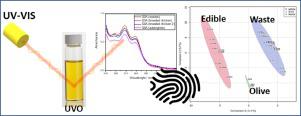Resources, Conservation and Recycling ( IF 11.2 ) Pub Date : 2021-11-30 , DOI: 10.1016/j.resconrec.2021.106088 Alberto Mannu , Matteo Poddighe , Sebastiano Garroni , Luca Malfatti

|
Due to the ever-increasing worldwide interest in the exploitation of waste vegetable oils, the development of analytical tools able to detect their adulteration with edible oils, is considered a priority for the scientific and industrial community. In this work, edible and waste vegetable oils have been analysed by Fourier Transform-InfraRed (FT-IR) and Ultraviolet-Visible (UV–VIS) spectroscopies and the corresponding spectral data subjected to statistical multivariate analysis for classification purposes. In particular, Principal Component Analysis (PCA) and Partial Least Square Discriminant Analysis (PLS-DA) were performed in order to develop an analytical tool which is able to distinguish between edible and waste vegetable oil. Qualitative analysis of the spectra suggested FT-IR and UV–VIS as the more suitable techniques to distinguish between wastes and edible samples. Also, statistical multivariate analysis revealed that FT-IR-based methodology is more adequate for the target, even if the elevated sensibility of the method produces an undesired distinction between edible oils of the same type. Finally, further attempts on UV–VIS data obtained in reflection mode allowed to produce a good dataset which after statistical treatment gave a clear differentiation between edible and waste oil samples.
中文翻译:

红外和紫外-可见光谱和多元分析在废植物油分类中的应用
由于世界范围内对废弃植物油的开发越来越感兴趣,开发能够检测其掺入食用油的分析工具被认为是科学和工业界的优先事项。在这项工作中,食用和废弃植物油已通过傅里叶变换红外 (FT-IR) 和紫外-可见 (UV-VIS) 光谱进行分析,并对相应的光谱数据进行统计多元分析以进行分类。特别是,进行了主成分分析 (PCA) 和偏最小二乘判别分析 (PLS-DA) 以开发一种能够区分食用植物油和废弃植物油的分析工具。光谱的定性分析表明 FT-IR 和 UV-VIS 是区分废物和可食用样品的更合适的技术。此外,统计多变量分析表明,基于 FT-IR 的方法更适合目标,即使该方法的敏感性提高会在相同类型的食用油之间产生不希望的区别。最后,对以反射模式获得的 UV-VIS 数据的进一步尝试可以产生一个良好的数据集,经过统计处理后,可明确区分食用油和废油样品。











































 京公网安备 11010802027423号
京公网安备 11010802027423号